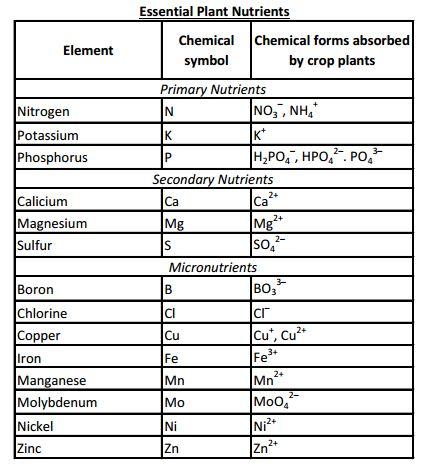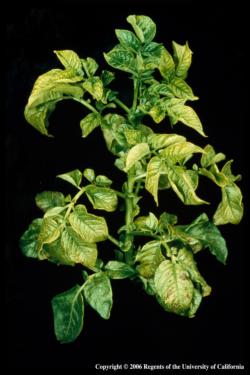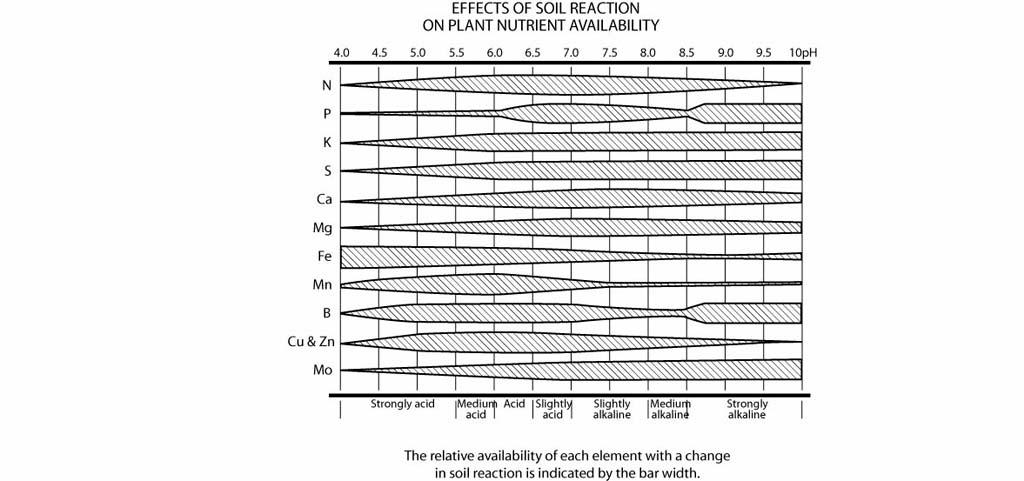Crop Nutrient Requirements
What are crop nutrient requirements?
Nutrient management is critical in order to increase or maintain crop yields on a single parcel of agricultural land. To meet crop needs throughout a growing season soil fertility must be consistently high. There are fourteen nutrients that are supplied to crops from soil and fertilizer sources. Of these, 6 are generally considered macronutrients, while the rest are micronutrients. Macronutrients are used in relatively larger amounts by the plant, however micronutrient deficiencies can be equally damaging to yield and profitability.

Determining nutrient needs

Soil testing is a critical component in determining those nutrients that are already available and those that may be in limited supply. Deficiencies will impact crop quality or yield and knowing these will assist in determining the amount and type of fertilizer required. Soil testing, however, is highly dependent on appropriate soil sampling on an individual field basis. Proper soil sampling guidelines can be accessed through online and through extension resources.
Plant tissue analysis may also be used as a method for measuring nutrient levels of a plant during their growth. This analysis is a useful tool for growers looking to understand the effectiveness of their fertilization practices. Tissue analysis may also be appropriate for diagnosing certain production problems. Similar to soil testing, however, plant tissue analysis is only as good as the samples that are submitted. Proper plant tissue sampling guidelines are available online or from local extension advisers.
Crop nutrients
Nitrogen (N), phosphorous (P), and potassium (K) are the three main nutrients that are conventionally supplied by inorganic fertilizers. Nutrients may also be supplied by other products and processes such as organic manures, plants residues, and biological nitrogen fixation. Practical nutrient requirements for certain crops should come from regionally specific guidelines dependent on the crop, environmental factors such as soil type and weather conditions, and the nutrient being applied.
Nitrogen: Nitrogen is an essential macronutrient for plant growth and is one of the most abundant elements in the earth’s atmosphere and surface. Nitrogen deficiency, however, is one of the most prevalent crop nutrient problems around the world. The reason for widespread shortages is that most of the N in the atmosphere and in the earth’s crust is not available for immediate uptake by plants. Most organic forms of N, such as the N found in plant residue, soil organic matter, or bacteria, are not available to plants. However, many spoil microorganisms are able to convert organic N into a plant available inorganic form, a process referred to as mineralization. Although not directly available for plant uptake, organic N is an important factor in soil health because it is relatively stable within the system, and can provide plants with a long-term slow release of N. Mineral N in the inorganic forms ammonium ( NH4+) and nitrate (NO3-) are plant available forms, however NO3- is also quite susceptible to being lost from the system because it is water soluble and does not interact with soil particles.
Phosphorous: Phosphorous is an essential macronutrient for plant reproduction, which may significantly impact grain or fruit yield. P deficiency is a common problem causing crop stunting or discoloration in the field. One of the major contributing sources of P for crops comes from soil organic matter. This soil organic matter will generally contain a range of organic P compounds, which must be converted into inorganic phosphate by soil microorganisms in order to be taken up by plants. Soil organic matter can be an excellent source of stable organic P compounds that can be released over time, however the P available to plants is only found dissolved in the soil solution. Soluble P is a small fraction of the total P in the soils. Even much of the P added to a system through compost, manure, or fertilizer is immobilized in soil. For this reason the efficiency of P fertilizer may be low.

Potassium: Soil potassium is an essential macronutrient for crops and can generally be found in three forms in an agricultural system. The K immediately usable by plants is found within the soil solution. Though this form is most significant for plant uptake, it is only a small fraction of the total K in the soil. Exchangeable K and mineral forms of K are far more prevalent within the soil. Mineral K is the most stable form and is generally tightly held within the soil itself. The availability of this form of the nutrient is fairly low for crop uptake. Exchangeable K, on the other hand, is an important pool of the K available for crop growths. This form of K is a positively charged ion that is loosely attracted to the negatively charged surfaces of soil particles.
Secondary Nutrients: Calcium (Ca), magnesium (Mg), and sulfur (S), are considered secondary macronutrients, or secondary nutrients, because they are required in amounts smaller than typically needed for N, P, or K. These elements, however, are equally important for plant growth and nutrition. Often, adequate amounts of these nutrients can be found in the soil and supplied to crops from chemical weathering or atmospheric deposition.
Micronutrients: Micronutrients are essential nutrients for plant growth that are used in relatively small amounts by crops. Boron (B), zinc (Zn), manganese (Mn), iron (Fe), copper (Cu), molybdenum (Mo), nickel (Ni), and chlorine (Cl) will only make up a small proportion of a plant; however, a deficiency in any of these elements has the potential to cause a decrease in crop quality or yield. In contrast, excess availability may cause toxicity. The availability of each of these micronutrients will depend on environmental and soil conditions. While visual clues may point a grower in the right direction towards identifying deficiencies, the most common method for determining deficiencies is through soil testing or plant tissue analysis. The most common method for ensuring proper micronutrient content within the soil is through increasing and enhancing the soil organic matter, which can be seen as a reservoir for holding stable forms of nutrients. In many cases, micronutrients can also be supplied with foliar sprays.
Additional factors
Beyond accounting for adequate amounts of all essential plant nutrients, growers should be aware of a variety of other factors that will impact nutrient uptake and availability. Soil chemical and physical properties, such as the parent material, texture, organic matter content, or permeability, will greatly impact the accessibility of certain nutrients for plant uptake. Water content is also important because nutrients available to plants are dissolved in the soil solution. Excess water, however, may deplete soil oxygen leading to an increased concentration of carbon dioxide.
Soil pH is a measure of the acidity of the soil. The pH can directly impact the concentration of certain mineral elements or their availability for crop uptake. Soil acidification, or a decrease in the soil pH, may be caused by long-term fertilizer application and other crop management practices. To account for this, growers may consider applying lime or other amendments to increase the soil pH. For many crops a mid-level pH allows for the most accessibility to nutrients, though specific recommendations for particular nutrients should be considered. Crops also have different pH requirements. This online resource can help growers meet specific guidelines while the graph below depicts general nutrient availability.

D.R. Pittenger, UCCE Riverside
In addition to a lack of accessibility caused by environmental or soil conditions, some nutrients may be lost from a system due to leaching, volatilization, or runoff. Nitrogen may be readily leached from an agricultural system. These losses often occur with drainage after rain or irrigation events. All three primary macronutrients and many secondary or micronutrients are also susceptible to the effects of runoff and erosion. Intense rain events may carry soil particles and adsorbed nutrients across the soil surface into streams or lakes. Some nutrients, such as N, are also highly susceptible to volatilization. This is the loss of a nutrient to the atmosphere after it has been transformed into a gaseous state. Nutrients removed from a system with crop harvest should also be considered and can be calculated for specific crops using online tools.
Crop Specific Guidelines
UC Davis scientists in collaboration with CDFA have produced useful online guidelines for crop specific fertilization.
This nutrient budget worksheet is also helpful.
